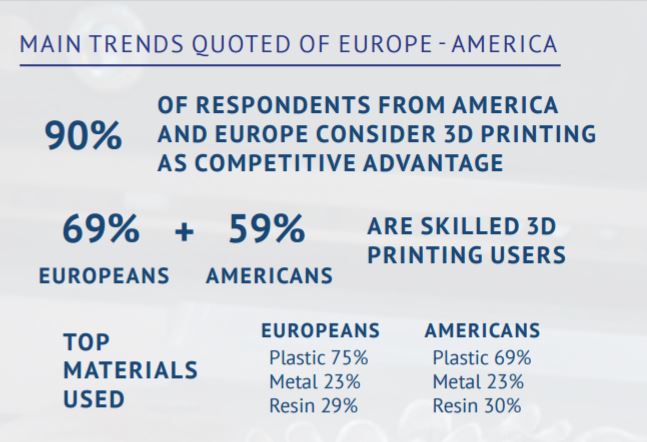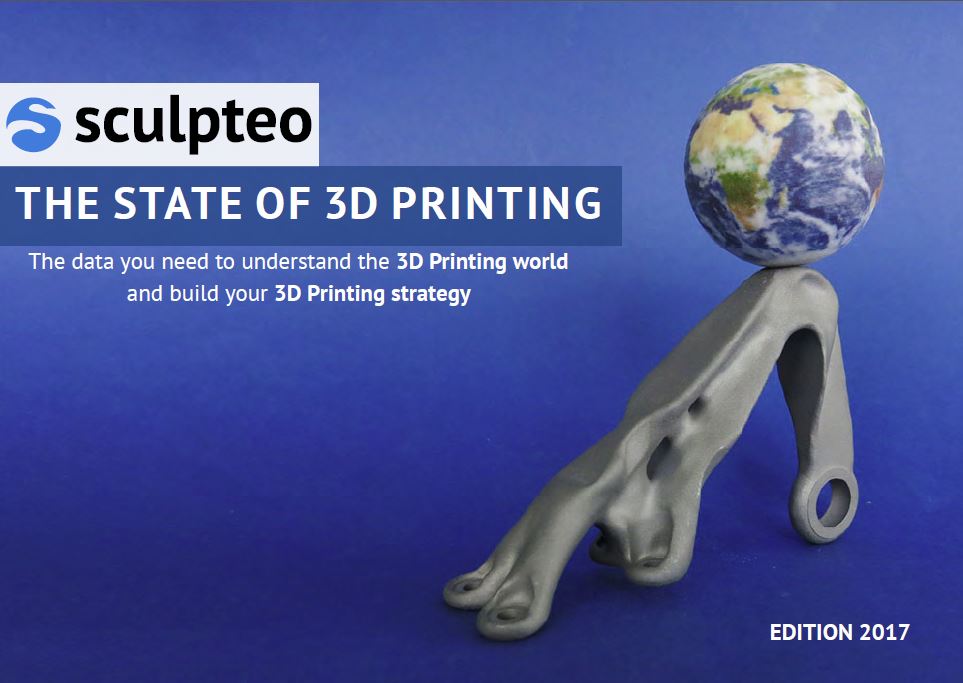3D Printing Trends in Europe versus in America
Posted By Hilmiyati Kusnadi on Jun 21, 2017 | 0 comments
The third edition of the State of 3D Printing gives us a clear view of the evolution of additive manufacturing. For the study conducted by our team between January and March 2017, we received the answers from nearly 1.000 respondents from 62 different countries. The majority comes from Europe (60%) and America (30%). In this article, we will compare the results of our European and American respondents to discover what are the main trends regarding 3D printing for each continent.
1. Applications differ
Concerning the 3D printing applications, Americans adopt this digital manufacturing technique mainly for design and production (23% and 17% versus 18% and 14%) while Europeans use it mostly for R&D purposes (26% against 18%).
Moreover, when it comes to the benefit of using 3D printing, Europeans and Americans agree that complex geometries (21%) is the principal motivation followed by cost reduction (18% for Europe versus 16% for America).
2. Different levels of expertise and integration
In fact, Americans indeed have more years of experience in additive manufacturing: 3.13 years versus 2.82 years for Europeans. However, Americans still consider themselves as less experimented than Europeans (20% against 22%). As a result, to gain more expertise, 3D printing is settling more into companies’ programs than in Europe (43% versus 34%).
For Americans, price (66%), quality of prints (61%) and materials (46%) are the main standards when choosing a 3D printing service, while Europeans are more concerned about the quality of prints (66%), price (64%) and then materials (48%). Nevertheless, Americans use more external services in order to produce 3D printed parts, whereas Europeans prefer to do it in-house.
3. Materials and technologies used
Regarding the materials chosen for 3D printing, Americans tend to use less plastic materials (69%) than Europeans (75%). Resin ranks second, followed by metal as the third most used kind of material for both continents.
Fused Deposition Modeling (FDM) is the technology that is the most used by Americans (41%), while Europe uses mostly SLS technology (31%). Moreover, the use of finishes between these two continents is quite similar.
Refer to our material pages: Plastics, Metals (SLM and DMLS), and Resin (CLIP and Polyjet) for further information regarding this point.
You can also read the article “Metal 3D Printing: A game-changing technology” to know about the general use of metal materials according to the State of 3D Printing.
4. Our respondents and their competitors
Both continents have their own way to differentiate themselves from their competitors. For Americans, customization (33%) and product/service quality (24%) are the key strategies to distinguish themselves from their competitors. On the other hand, Europe is doing the opposite by using 3D printing for product/service quality (35%) followed by customization (20%).
However, these two continents don’t share the same vision of their competitors. Indeed, 74% of Americans believe that their competitors use 3D printing, while only 59% of Europeans think so. The other half of Europeans (41%) think that they are the only ones using 3D printing, while only 23% of Americans believe that they are the only 3D printing users.
5. Expenses increase in the same way
Americans and Europeans invested the same amount of money in 3D printing. Over the past year, the expenses have increased by 59% for Europe versus 61% for America. Also, 69% of the respondents from both continents, expect their 3D printing expenses to raise for the next year. 90% of the respondents from both continents consider 3D printing is a competitive advantage.
In terms of Return on Investment, the perception isn’t the same for both continents. Americans think that they have a better ROI for their 3D printing activities (45% versus 37% for Europeans). One thing that we can conclude from this point is that either in Europe or America, 3D printing is flourishing and more and more companies are willing to invest in additive manufacturing.
Download the State of 3D Printing 2017!
The State of 3D Printing is a study that exposes the current state of the additive manufacturing industry. Each year at Sculpteo, we collect these powerful insights to help you undertake the challenges you face. This report is divided into 4 sections:
- The main trends for 2017
- The focus strategy according to the high performers in 3D printing: the ‘Power Users’
- The year-over-year contrast, comparing the study from 2017-2016
- The sectorial insights
We hope you will find all the information you need in the State of 3D Printing to sharpen your strategy, launch your business or simply to get an update about the recent state of 3D printing.
You can download it here.


 Connect with Google
Connect with Google Connect with Facebook
Connect with Facebook

